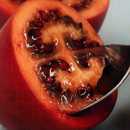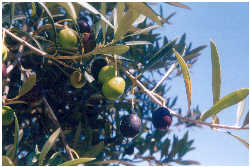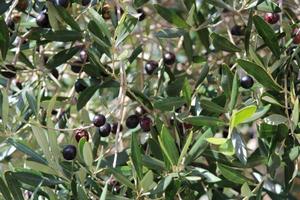|
Olives Hardy's Mammoth
clusters of white fluffy flowers in early summer followed by heavy yeilds of large sized oval fruit in autumn. The fruit is a deep brown in colour, tasty with a slight acidic finish. High in oil content, therefore great for pickling or pressing for your own oil. Habit - Small quick growing evergreen tree with a spreading habit. Hardy cultivar, frost tolerant. Ideal as a specimen tree or topiary, espaliered, in a container or grown as a hedge. Size - 4m x 3m Pollination - Olive trees are wind pollinated, with the pollen moving 20 - 30 metres from tree to tree. Some varieties are self fertile, but all will benefit from a pollinator. If planting specifically for pickling the fruit, choose a series of varieties that are all suitable for pickling so that harvesting is simplified. Harvest - Olives for oil production are harvested when black, but for pickling, some varieties are picked when changing from green to greenish yellow, and others are picked when turning black.
Good oil content. Variety Fruiting Time
|
||||||||||||||||||||||||||||||||||||||
|
Olives Kalamata
Greek olive. Large crops of large,almond-shaped, plump, light pink to dark purple glossy fruit. The fruit are meaty and juicy with small pits. Considered as a superior variety of table olive. Habit - Extremely hardy attractive evergreen medium to large sized tree with large silvery green leaves. Has weeping branches. Thrives in humid conditions. Grows well in most well-drained soils. Water deeply and regularly for the first couple of seasons while it establishs it's extensive root system, then it will tolerate droughts. Size - 6 x 6m Pollination - Olive trees are wind pollinated, with the pollen moving 20 - 30 metres from tree to tree. Some varieties are self fertile, but all will benefit from a pollinator. Mananillo and Koroneiki are ideal pollinators for Kalamata. Harvest - Harvest when the olives start to change colour from green to pinkish purple. Variety Fruiting Time
|
||||||||||||||||||||||||||||||||||||||
|
Olives Koroneiki
Heavy crops of small, oval and slightly asymmetricall fruit. The fruit are light green to dark purple in colour. Is famed for producing a high quality oil with an aromatic rich flavour. Also great for pickling for green or black table olives. High oil content. Habit - Extremely hardy attractive evergreen medium sized tree with silvery green leaves. Upright open habit. Performs well in warmer climates. Tolerant to wind and frost. Size - 6 x 6m Pollination - Olive trees are wind pollinated, with the pollen moving 20 - 30 metres from tree to tree. Some varieties are self fertile, but all will benefit from a pollinator. Harvest - Olives for oil production are harvested when black. But for pickling, some varieties are picked when changing from green to greenish yellow, and others are picked when turning black. Variety Fruiting Time
|
||||||||||||||||||||||||||||||||||||||
|
Olives Manzanillo
Spanish Cultivar. Heavy yield of medium sized fruit. Habit - Spreading habit. Requires hot summers and cold winters. Size - Can be maintained at 4m x 3m. Pollination - Olive trees are wind pollinated, with the pollen moving 20 - 30 metres from tree to tree. Some varieties are self fertile, but all will benefit from a pollinator. If planting specifically for pickling the fruit, choose a series of varieties that are all suitable for pickling so that harvesting is simplified. Harvest - Olives for oil production are harvested when black, but for pickling, some varieties are picked when changing from green to greenish yellow, and others are picked when turning black.
Good oil content. Fruit used mainly for pickling. |
||||||||||||||
|
Olives Tolley's Upright
Light yielding olives that are ideal for their oil. Habit - Extremely hardy attractive tree with silvery leaves. Upright habit, compact and symmetrical structure. Ideal as a specimen tree or topiary, espaliered, in a container or grown as a hedge. Size - 7m x 4m Pollination - Olive trees are wind pollinated, with the pollen moving 20 - 30 metres from tree to tree. Some varieties are self fertile, but all will benefit from a pollinator. If planting specifically for pickling the fruit, choose a series of varieties that are all suitable for pickling so that harvesting is simplified. Harvest - Olives for oil production are harvested when black, but for pickling, some varieties are picked when changing from green to greenish yellow, and others are picked when turning black.
Good oil content. |
||||||||||||||
|
Olives Verdale
Orginated in the southern olive regions of France. Large oval fruit with a pleasant flavour. Crops well. Great for pickling for green or black table olives. Low oil content Habit - Extremely hardy attractive evergreen medium sized tree with silvery green leaves. Upright open form with a slightly weeping habit. Ideal in areas with hot summers and cold winters. Tolerant to wind and frost. Resistant to Peacock Spot. Size - 4m x 3m Pollination - Olive trees are wind pollinated, with the pollen moving 20 - 30 metres from tree to tree. Some varieties are self fertile, but all will benefit from a pollinator. If planting specifically for pickling the fruit, choose a series of varieties that are all suitable for pickling so that harvesting is simplified. Harvest - Olives for oil production are harvested when black, but for pickling, some varieties are picked when changing from green to greenish yellow, and others are picked when turning black. Variety Fruiting Time
|
||||||||||||||||||||||||||||||||||||||





